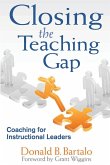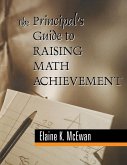- Gebundenes Buch
- Merkliste
- Auf die Merkliste
- Bewerten Bewerten
- Teilen
- Produkt teilen
- Produkterinnerung
- Produkterinnerung
Clear, updated guidelines for increasing academic performance and providing educational equity for all students! This revised guide outlines 50 strategies for developing high-performing schools. Emphasizing educational parity for all students, the book is organized around six standards: Teach a well-crafted, focused, valid, and clear curriculum Align assessments, programs, and instructional resources with curriculum Promote student equality and equity Focus on mastery learning and effective teaching strategies Provide resources for establishing curriculum expectations, monitoring, and…mehr
Andere Kunden interessierten sich auch für
![Teaching to Close the Achievement Gap for Students of Color Teaching to Close the Achievement Gap for Students of Color]() Teaching to Close the Achievement Gap for Students of Color64,99 €
Teaching to Close the Achievement Gap for Students of Color64,99 €![Teaching to Close the Achievement Gap for Students of Color Teaching to Close the Achievement Gap for Students of Color]() Teaching to Close the Achievement Gap for Students of Color204,99 €
Teaching to Close the Achievement Gap for Students of Color204,99 €![Closing the Achievement Gap Closing the Achievement Gap]() Tiffany Chane'l AndersonClosing the Achievement Gap10,99 €
Tiffany Chane'l AndersonClosing the Achievement Gap10,99 €![Eliminating the Achievement Gap Eliminating the Achievement Gap]() William JeynesEliminating the Achievement Gap129,99 €
William JeynesEliminating the Achievement Gap129,99 €![Closing the Teaching Gap Closing the Teaching Gap]() Donald B. BartaloClosing the Teaching Gap46,99 €
Donald B. BartaloClosing the Teaching Gap46,99 €![The Principal's Guide to Raising Math Achievement The Principal's Guide to Raising Math Achievement]() Elaine K. McEwanThe Principal's Guide to Raising Math Achievement36,99 €
Elaine K. McEwanThe Principal's Guide to Raising Math Achievement36,99 €![101 Stunts for Principals to Inspire Student Achievement 101 Stunts for Principals to Inspire Student Achievement]() Frank Sennett101 Stunts for Principals to Inspire Student Achievement36,99 €
Frank Sennett101 Stunts for Principals to Inspire Student Achievement36,99 €-
-
-
Clear, updated guidelines for increasing academic performance and providing educational equity for all students! This revised guide outlines 50 strategies for developing high-performing schools. Emphasizing educational parity for all students, the book is organized around six standards: Teach a well-crafted, focused, valid, and clear curriculum Align assessments, programs, and instructional resources with curriculum Promote student equality and equity Focus on mastery learning and effective teaching strategies Provide resources for establishing curriculum expectations, monitoring, and accountability Institute effective district and school planning, staff development, and resource allocation to create a quality learning environment
Hinweis: Dieser Artikel kann nur an eine deutsche Lieferadresse ausgeliefert werden.
Hinweis: Dieser Artikel kann nur an eine deutsche Lieferadresse ausgeliefert werden.
Produktdetails
- Produktdetails
- Verlag: Corwin
- 3. Auflage
- Seitenzahl: 336
- Erscheinungstermin: 26. September 2008
- Englisch
- Abmessung: 260mm x 183mm x 23mm
- Gewicht: 828g
- ISBN-13: 9781412958974
- ISBN-10: 1412958970
- Artikelnr.: 24663143
- Herstellerkennzeichnung
- Libri GmbH
- Europaallee 1
- 36244 Bad Hersfeld
- gpsr@libri.de
- Verlag: Corwin
- 3. Auflage
- Seitenzahl: 336
- Erscheinungstermin: 26. September 2008
- Englisch
- Abmessung: 260mm x 183mm x 23mm
- Gewicht: 828g
- ISBN-13: 9781412958974
- ISBN-10: 1412958970
- Artikelnr.: 24663143
- Herstellerkennzeichnung
- Libri GmbH
- Europaallee 1
- 36244 Bad Hersfeld
- gpsr@libri.de
Carolyn J. Downey is professor emeritus of educational leadership in the College of Education at San Diego State University. She formerly was the superintendent for the Kyrene School District, Phoenix-Tempe, Arizona. Downey has written several books and numerous articles. She is the author of the training program "The Three-Minute Walk-Through and Reflective Feedback for Higher Student Achievement." Her most recent book with Betty E. Steffy, William K. Poston Jr., and Fenwick W. English is 50 Ways to Close the Achievement Gap. She was the major architect of the CMSI Individual School Audit using the 50 Characteristics for Higher Student Achievement. She is the author of several of the Principal-Teacher Series for Higher Student Achievement training materials. She received her MS from the University of Southern California and her PhD from Arizona State University.
Preface
Acknowledgments
About the Authors
Introduction
Six Standards for High-Performing Schools
1. Standard One: Establish a Well-Crafted, Focused, Valid, and Clear
Curriculum to Direct Teaching
Strategy 1: Embed External Assessment Target Objectives in the Written
Content Standards and Link to State Standards
Strategy 2: Have Clear and Precise District Curriculum Objectives -
Content, Context, and Cognitive Type
Strategy 3: Deeply Align Objectives From External Assessments
Strategy 4: Sequence Objectives for Mastery Well Before They Are Tested
Strategy 5: Provide a Feasible Number of Objectives to Be Taught
Strategy 6: Identify Specific Objectives as Benchmark Standards
Strategy 7: Place Objectives in a Teaching Sequence
Strategy 8: Provide Access to Written Curriculum Documents and Direct the
Objectives to Be Taught
Strategy 9: Conduct Staff Development in Curriculum and Its Delivery
2. Standard Two: Provide Assessments Aligned With the Curriculum
Strategy 10: Develop Aligned District Pre-Post Criterion-Referenced
Assessments
Strategy 11: Have a Pool of Unsecured Test Items by Objective
Strategy 12: Establish Secured Performance Benchmark Assessments
Strategy 13: Conduct Assessment Training
Strategy 14: Use Assessments Diagnostically
Strategy 15: Teach Students to Be "Test Wise"
Strategy 16: Establish a Reasonable Testing Schedule and Environment
Strategy 17: Disaggregate Assessment Data
Strategy 18: Maintain Student Progress Reports
3. Standard Three: Align Program and Instructional Resources With the
Curriculum and Provide Student Equality and Equity
Strategy 19: Align Programs With the Curriculum to Ensure Congruity
Strategy 20: Use Research Data That Document Results to Drive Program
Selection, and Validate the Implementation of Programs With Action Research
Strategy 21: Evaluate Programs to Determine Their Effectiveness in
Strengthening Student Achievement of Curriculum Objectives
Strategy 22: Align Textbooks and Instructional Resources With the District
Curriculum Objectives and Assessment in Both Content and Context Dimensions
Strategy 23: Use Technology in Design or Selection Procedures to Ensure
Strong Connections to System Learning Expectations and Feedback
Strategy 24: Provide Training in the Use of Instructional Resources and
Their Alignment With System Curriculum Objectives - Content, Context, and
Cognitive Type
Strategy 25: Select or Modify Instructional Resources for Lessons to Ensure
Full Alignment With System Objectives and Tested Learning
Strategy 26: Place Students in Programs and Activities in an Equitable
Manner and With Equal Access to the Curriculum
Strategy 27: Implement Effective Programs and Strategies With English
Language Learners
4. Standard Four: Use a Mastery Learning Approach and Effective Teaching
Strategies
Strategy 28: Implement a Mastery Learning Model
Strategy 29: Align Teaching With the Curriculum
Strategy 30: Provide Differentiated Curriculum and Instruction as Well as
Differentiated Time to Learn
Strategy 31: Provide Practice to Master the Curriculum
Strategy 32: Use Effective Instructional Practices
Strategy 33: Use Powerful Vocabulary Development Strategies
Strategy 34: Establish Individual Learning Plans for Low-Achieving Students
5. Standard Five: Establish Curriculum Expectations, Monitoring, and
Accountability
Strategy 35: Provide for High Expectations for Achievement for Each Student
Strategy 36: Monitor the Curriculum
Strategy 37: Visit Classrooms and Provide Follow-up
Strategy 38: Use Disaggregated Data in the Decision-Making Process
Strategy 39: Focus Staff Appraisal on Professional Growth
6. Standard Six: Institute Effective District and School Planning, Staff
Development, and Resource Allocations, and Provide a Quality Learning
Environment
Strategy 40: Develop a District Planning Process That Is Strategic in
Nature and Provides Guidance for the Development of District and School
Long-Range Plans
Strategy 41: Create and Implement a Singular, Focused, Multiyear District
Plan That Incorporates Change Strategies for Higher Student Achievement
Strategy 42: Align School Plans With the District Plan
Strategy 43: Implement Aligned Teacher Training to Reach District and
School Goals
Strategy 44: Implement Administrative Training Aligned With the Curriculum
and Its Assessment and District Plan Priorities
Strategy 45: Provide Differentiated Staff Development
Strategy 46: Link Resource Allocations to Goals, Objectives, Priorities,
and Diagnosed Needs of the System
Strategy 47: Provide Qualified and Adequate Personnel
Strategy 48: Remove Incompetent Staff or Help Them Achieve Satisfactory
Functioning
Strategy 49: Provide a Quality Learning Environment
Strategy 50: Provide Quality Facilities
Summary
References
Index
Acknowledgments
About the Authors
Introduction
Six Standards for High-Performing Schools
1. Standard One: Establish a Well-Crafted, Focused, Valid, and Clear
Curriculum to Direct Teaching
Strategy 1: Embed External Assessment Target Objectives in the Written
Content Standards and Link to State Standards
Strategy 2: Have Clear and Precise District Curriculum Objectives -
Content, Context, and Cognitive Type
Strategy 3: Deeply Align Objectives From External Assessments
Strategy 4: Sequence Objectives for Mastery Well Before They Are Tested
Strategy 5: Provide a Feasible Number of Objectives to Be Taught
Strategy 6: Identify Specific Objectives as Benchmark Standards
Strategy 7: Place Objectives in a Teaching Sequence
Strategy 8: Provide Access to Written Curriculum Documents and Direct the
Objectives to Be Taught
Strategy 9: Conduct Staff Development in Curriculum and Its Delivery
2. Standard Two: Provide Assessments Aligned With the Curriculum
Strategy 10: Develop Aligned District Pre-Post Criterion-Referenced
Assessments
Strategy 11: Have a Pool of Unsecured Test Items by Objective
Strategy 12: Establish Secured Performance Benchmark Assessments
Strategy 13: Conduct Assessment Training
Strategy 14: Use Assessments Diagnostically
Strategy 15: Teach Students to Be "Test Wise"
Strategy 16: Establish a Reasonable Testing Schedule and Environment
Strategy 17: Disaggregate Assessment Data
Strategy 18: Maintain Student Progress Reports
3. Standard Three: Align Program and Instructional Resources With the
Curriculum and Provide Student Equality and Equity
Strategy 19: Align Programs With the Curriculum to Ensure Congruity
Strategy 20: Use Research Data That Document Results to Drive Program
Selection, and Validate the Implementation of Programs With Action Research
Strategy 21: Evaluate Programs to Determine Their Effectiveness in
Strengthening Student Achievement of Curriculum Objectives
Strategy 22: Align Textbooks and Instructional Resources With the District
Curriculum Objectives and Assessment in Both Content and Context Dimensions
Strategy 23: Use Technology in Design or Selection Procedures to Ensure
Strong Connections to System Learning Expectations and Feedback
Strategy 24: Provide Training in the Use of Instructional Resources and
Their Alignment With System Curriculum Objectives - Content, Context, and
Cognitive Type
Strategy 25: Select or Modify Instructional Resources for Lessons to Ensure
Full Alignment With System Objectives and Tested Learning
Strategy 26: Place Students in Programs and Activities in an Equitable
Manner and With Equal Access to the Curriculum
Strategy 27: Implement Effective Programs and Strategies With English
Language Learners
4. Standard Four: Use a Mastery Learning Approach and Effective Teaching
Strategies
Strategy 28: Implement a Mastery Learning Model
Strategy 29: Align Teaching With the Curriculum
Strategy 30: Provide Differentiated Curriculum and Instruction as Well as
Differentiated Time to Learn
Strategy 31: Provide Practice to Master the Curriculum
Strategy 32: Use Effective Instructional Practices
Strategy 33: Use Powerful Vocabulary Development Strategies
Strategy 34: Establish Individual Learning Plans for Low-Achieving Students
5. Standard Five: Establish Curriculum Expectations, Monitoring, and
Accountability
Strategy 35: Provide for High Expectations for Achievement for Each Student
Strategy 36: Monitor the Curriculum
Strategy 37: Visit Classrooms and Provide Follow-up
Strategy 38: Use Disaggregated Data in the Decision-Making Process
Strategy 39: Focus Staff Appraisal on Professional Growth
6. Standard Six: Institute Effective District and School Planning, Staff
Development, and Resource Allocations, and Provide a Quality Learning
Environment
Strategy 40: Develop a District Planning Process That Is Strategic in
Nature and Provides Guidance for the Development of District and School
Long-Range Plans
Strategy 41: Create and Implement a Singular, Focused, Multiyear District
Plan That Incorporates Change Strategies for Higher Student Achievement
Strategy 42: Align School Plans With the District Plan
Strategy 43: Implement Aligned Teacher Training to Reach District and
School Goals
Strategy 44: Implement Administrative Training Aligned With the Curriculum
and Its Assessment and District Plan Priorities
Strategy 45: Provide Differentiated Staff Development
Strategy 46: Link Resource Allocations to Goals, Objectives, Priorities,
and Diagnosed Needs of the System
Strategy 47: Provide Qualified and Adequate Personnel
Strategy 48: Remove Incompetent Staff or Help Them Achieve Satisfactory
Functioning
Strategy 49: Provide a Quality Learning Environment
Strategy 50: Provide Quality Facilities
Summary
References
Index
Preface
Acknowledgments
About the Authors
Introduction
Six Standards for High-Performing Schools
1. Standard One: Establish a Well-Crafted, Focused, Valid, and Clear
Curriculum to Direct Teaching
Strategy 1: Embed External Assessment Target Objectives in the Written
Content Standards and Link to State Standards
Strategy 2: Have Clear and Precise District Curriculum Objectives -
Content, Context, and Cognitive Type
Strategy 3: Deeply Align Objectives From External Assessments
Strategy 4: Sequence Objectives for Mastery Well Before They Are Tested
Strategy 5: Provide a Feasible Number of Objectives to Be Taught
Strategy 6: Identify Specific Objectives as Benchmark Standards
Strategy 7: Place Objectives in a Teaching Sequence
Strategy 8: Provide Access to Written Curriculum Documents and Direct the
Objectives to Be Taught
Strategy 9: Conduct Staff Development in Curriculum and Its Delivery
2. Standard Two: Provide Assessments Aligned With the Curriculum
Strategy 10: Develop Aligned District Pre-Post Criterion-Referenced
Assessments
Strategy 11: Have a Pool of Unsecured Test Items by Objective
Strategy 12: Establish Secured Performance Benchmark Assessments
Strategy 13: Conduct Assessment Training
Strategy 14: Use Assessments Diagnostically
Strategy 15: Teach Students to Be "Test Wise"
Strategy 16: Establish a Reasonable Testing Schedule and Environment
Strategy 17: Disaggregate Assessment Data
Strategy 18: Maintain Student Progress Reports
3. Standard Three: Align Program and Instructional Resources With the
Curriculum and Provide Student Equality and Equity
Strategy 19: Align Programs With the Curriculum to Ensure Congruity
Strategy 20: Use Research Data That Document Results to Drive Program
Selection, and Validate the Implementation of Programs With Action Research
Strategy 21: Evaluate Programs to Determine Their Effectiveness in
Strengthening Student Achievement of Curriculum Objectives
Strategy 22: Align Textbooks and Instructional Resources With the District
Curriculum Objectives and Assessment in Both Content and Context Dimensions
Strategy 23: Use Technology in Design or Selection Procedures to Ensure
Strong Connections to System Learning Expectations and Feedback
Strategy 24: Provide Training in the Use of Instructional Resources and
Their Alignment With System Curriculum Objectives - Content, Context, and
Cognitive Type
Strategy 25: Select or Modify Instructional Resources for Lessons to Ensure
Full Alignment With System Objectives and Tested Learning
Strategy 26: Place Students in Programs and Activities in an Equitable
Manner and With Equal Access to the Curriculum
Strategy 27: Implement Effective Programs and Strategies With English
Language Learners
4. Standard Four: Use a Mastery Learning Approach and Effective Teaching
Strategies
Strategy 28: Implement a Mastery Learning Model
Strategy 29: Align Teaching With the Curriculum
Strategy 30: Provide Differentiated Curriculum and Instruction as Well as
Differentiated Time to Learn
Strategy 31: Provide Practice to Master the Curriculum
Strategy 32: Use Effective Instructional Practices
Strategy 33: Use Powerful Vocabulary Development Strategies
Strategy 34: Establish Individual Learning Plans for Low-Achieving Students
5. Standard Five: Establish Curriculum Expectations, Monitoring, and
Accountability
Strategy 35: Provide for High Expectations for Achievement for Each Student
Strategy 36: Monitor the Curriculum
Strategy 37: Visit Classrooms and Provide Follow-up
Strategy 38: Use Disaggregated Data in the Decision-Making Process
Strategy 39: Focus Staff Appraisal on Professional Growth
6. Standard Six: Institute Effective District and School Planning, Staff
Development, and Resource Allocations, and Provide a Quality Learning
Environment
Strategy 40: Develop a District Planning Process That Is Strategic in
Nature and Provides Guidance for the Development of District and School
Long-Range Plans
Strategy 41: Create and Implement a Singular, Focused, Multiyear District
Plan That Incorporates Change Strategies for Higher Student Achievement
Strategy 42: Align School Plans With the District Plan
Strategy 43: Implement Aligned Teacher Training to Reach District and
School Goals
Strategy 44: Implement Administrative Training Aligned With the Curriculum
and Its Assessment and District Plan Priorities
Strategy 45: Provide Differentiated Staff Development
Strategy 46: Link Resource Allocations to Goals, Objectives, Priorities,
and Diagnosed Needs of the System
Strategy 47: Provide Qualified and Adequate Personnel
Strategy 48: Remove Incompetent Staff or Help Them Achieve Satisfactory
Functioning
Strategy 49: Provide a Quality Learning Environment
Strategy 50: Provide Quality Facilities
Summary
References
Index
Acknowledgments
About the Authors
Introduction
Six Standards for High-Performing Schools
1. Standard One: Establish a Well-Crafted, Focused, Valid, and Clear
Curriculum to Direct Teaching
Strategy 1: Embed External Assessment Target Objectives in the Written
Content Standards and Link to State Standards
Strategy 2: Have Clear and Precise District Curriculum Objectives -
Content, Context, and Cognitive Type
Strategy 3: Deeply Align Objectives From External Assessments
Strategy 4: Sequence Objectives for Mastery Well Before They Are Tested
Strategy 5: Provide a Feasible Number of Objectives to Be Taught
Strategy 6: Identify Specific Objectives as Benchmark Standards
Strategy 7: Place Objectives in a Teaching Sequence
Strategy 8: Provide Access to Written Curriculum Documents and Direct the
Objectives to Be Taught
Strategy 9: Conduct Staff Development in Curriculum and Its Delivery
2. Standard Two: Provide Assessments Aligned With the Curriculum
Strategy 10: Develop Aligned District Pre-Post Criterion-Referenced
Assessments
Strategy 11: Have a Pool of Unsecured Test Items by Objective
Strategy 12: Establish Secured Performance Benchmark Assessments
Strategy 13: Conduct Assessment Training
Strategy 14: Use Assessments Diagnostically
Strategy 15: Teach Students to Be "Test Wise"
Strategy 16: Establish a Reasonable Testing Schedule and Environment
Strategy 17: Disaggregate Assessment Data
Strategy 18: Maintain Student Progress Reports
3. Standard Three: Align Program and Instructional Resources With the
Curriculum and Provide Student Equality and Equity
Strategy 19: Align Programs With the Curriculum to Ensure Congruity
Strategy 20: Use Research Data That Document Results to Drive Program
Selection, and Validate the Implementation of Programs With Action Research
Strategy 21: Evaluate Programs to Determine Their Effectiveness in
Strengthening Student Achievement of Curriculum Objectives
Strategy 22: Align Textbooks and Instructional Resources With the District
Curriculum Objectives and Assessment in Both Content and Context Dimensions
Strategy 23: Use Technology in Design or Selection Procedures to Ensure
Strong Connections to System Learning Expectations and Feedback
Strategy 24: Provide Training in the Use of Instructional Resources and
Their Alignment With System Curriculum Objectives - Content, Context, and
Cognitive Type
Strategy 25: Select or Modify Instructional Resources for Lessons to Ensure
Full Alignment With System Objectives and Tested Learning
Strategy 26: Place Students in Programs and Activities in an Equitable
Manner and With Equal Access to the Curriculum
Strategy 27: Implement Effective Programs and Strategies With English
Language Learners
4. Standard Four: Use a Mastery Learning Approach and Effective Teaching
Strategies
Strategy 28: Implement a Mastery Learning Model
Strategy 29: Align Teaching With the Curriculum
Strategy 30: Provide Differentiated Curriculum and Instruction as Well as
Differentiated Time to Learn
Strategy 31: Provide Practice to Master the Curriculum
Strategy 32: Use Effective Instructional Practices
Strategy 33: Use Powerful Vocabulary Development Strategies
Strategy 34: Establish Individual Learning Plans for Low-Achieving Students
5. Standard Five: Establish Curriculum Expectations, Monitoring, and
Accountability
Strategy 35: Provide for High Expectations for Achievement for Each Student
Strategy 36: Monitor the Curriculum
Strategy 37: Visit Classrooms and Provide Follow-up
Strategy 38: Use Disaggregated Data in the Decision-Making Process
Strategy 39: Focus Staff Appraisal on Professional Growth
6. Standard Six: Institute Effective District and School Planning, Staff
Development, and Resource Allocations, and Provide a Quality Learning
Environment
Strategy 40: Develop a District Planning Process That Is Strategic in
Nature and Provides Guidance for the Development of District and School
Long-Range Plans
Strategy 41: Create and Implement a Singular, Focused, Multiyear District
Plan That Incorporates Change Strategies for Higher Student Achievement
Strategy 42: Align School Plans With the District Plan
Strategy 43: Implement Aligned Teacher Training to Reach District and
School Goals
Strategy 44: Implement Administrative Training Aligned With the Curriculum
and Its Assessment and District Plan Priorities
Strategy 45: Provide Differentiated Staff Development
Strategy 46: Link Resource Allocations to Goals, Objectives, Priorities,
and Diagnosed Needs of the System
Strategy 47: Provide Qualified and Adequate Personnel
Strategy 48: Remove Incompetent Staff or Help Them Achieve Satisfactory
Functioning
Strategy 49: Provide a Quality Learning Environment
Strategy 50: Provide Quality Facilities
Summary
References
Index








